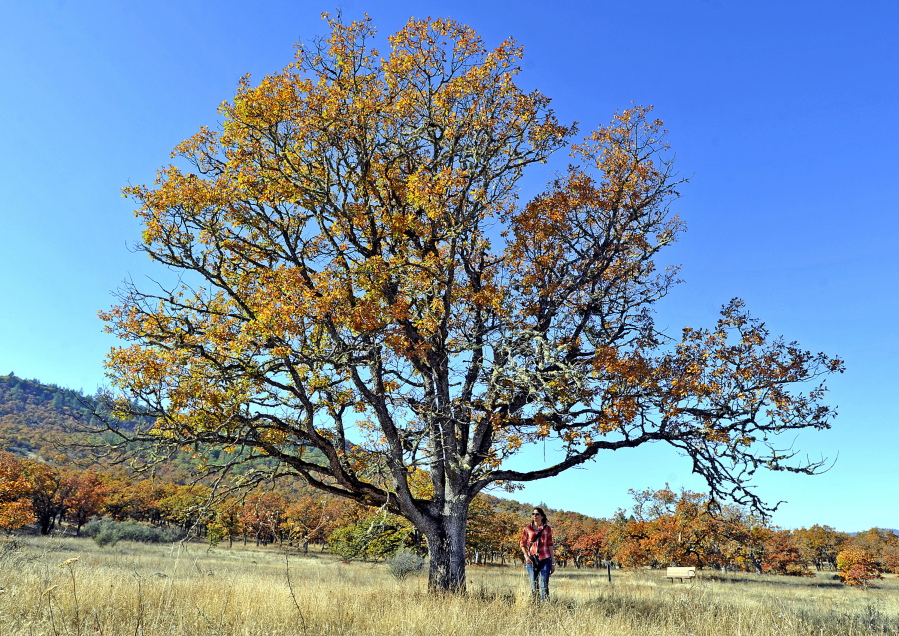MEDFORD, Ore. — A patch of oak savanna along the slopes of Lower Table Rock that was rehabbed last year already is showing enough signs of health that the warblers have taken notice.
There are fewer conifer-loving hermit warblers now that encroaching pine and firs have been systematically removed, and they’re being replaced by oak-loving black-throated gray warblers.
“We’ve already seen this shift,” says Jaime Stephens, science director for the Ashland-based Klamath Bird Observatory, which is inventorying bird use of these and other oak habitats. “The birds are telling us the story, in addition to what the oaks are telling us.”
Early chapter
This story could be an early chapter in a novel approach grass-roots groups like KBO have embarked on throughout the Pacific Northwest to reclaim lost and overrun oak habitats and the animals that rely on them in the face of climate change.
The groups plan to restore oak savannas in key places so oak-associated birds such as the oak titmouse can hopscotch their way north to escape what is expected to be warming environmental conditions hostile to their environs.
A consortium of public and private entities coming together as the Klamath-Siskiyou Oak Network last week received a $100,185 grant from the Oregon Watershed Enhancement Board to create a plan to identify these habitats in the Klamath-Siskiyou region, what treatments they need and prioritize what work needs to be done.
They’ve joined forces with other groups in the Willamette Valley and the east Cascades to do similar restoration work on oak woodlands and prairies there. They are part of an Oregon effort that involves 50 groups protecting and enhancing oak habitat from Northern California to the Canadian border.
A business plan put together by the groups estimates that restoring oak savannas from Northern California to Canada would cost about $83 million, with the Klamath-Siskiyou region accounting for $18.35 million of it.
Stephens says the blueprint for southern Oregon’s contribution to this effort should be in place by the end of 2019, and the groups hope to have the projects done within 15 years, depending upon funding.
Other partners in the Klamath-Siskiyou Oak Network include The Nature Conservancy, the Bureau of Land Management, U.S. Fish and Wildlife Service, U.S. Natural Resources Conservation Service, U.S. Forest Service and Lomakasti Restoration Project.
Lomakatsi is a contractor that has worked on oak restoration in recent years at the Table Rocks and the Colestin Valley southwest of Ashland.
Oaks always have been the other white meat of western Oregon tree habitats, playing second fiddle to Douglas fir, Ponderosa pine and other more merchantable species. Much of western Oregon’s oak habitat has given way to development from ranches, farms and cities in the relatively flat bottomlands oaks prefer.
Studies show only 1 percent of oak habitats remains in the Willamette Valley and about one-third in the Umpqua Valley, but no estimate for the Rogue Valley, Stephens says.
There is no estimate for the amount of lost oak savanna in the Rogue Valley.
“We just don’t really know how much we had historically and what we have left,” Stephens says.
Often those that do remain are fighting enemies from above and below.
Encroaching conifers overshadow the oaks, while dense underbrush creates unnatural wildfire conditions that could lead to burns that threaten oak crowns.
Treatments like those along Lower Table Rock last year include removing the conifers as well as clearing and burning brush so fires that move through burn less hot and help cleanse oak habitat.
Stephens says about $2 million in grant money already has been spent on oak restoration here in recent years as more people understand the needs of these gnarly, resident hardwoods.
“It’s really a grass-roots approach in all these regions in the Pacific Northwest,” Stephens says. “There’s a recognition now of the historic loss and the animals that use them. People connect to oaks.”



